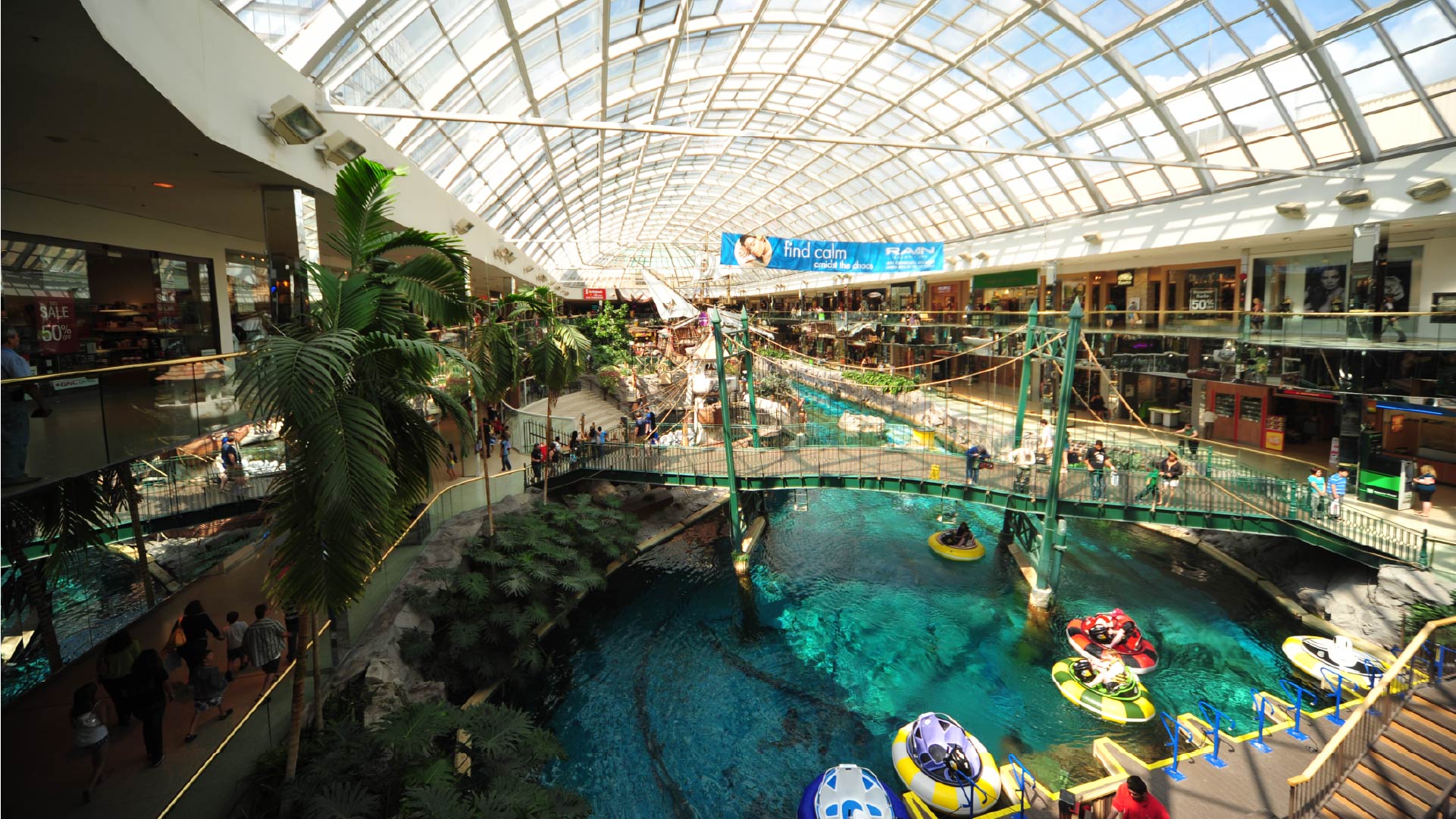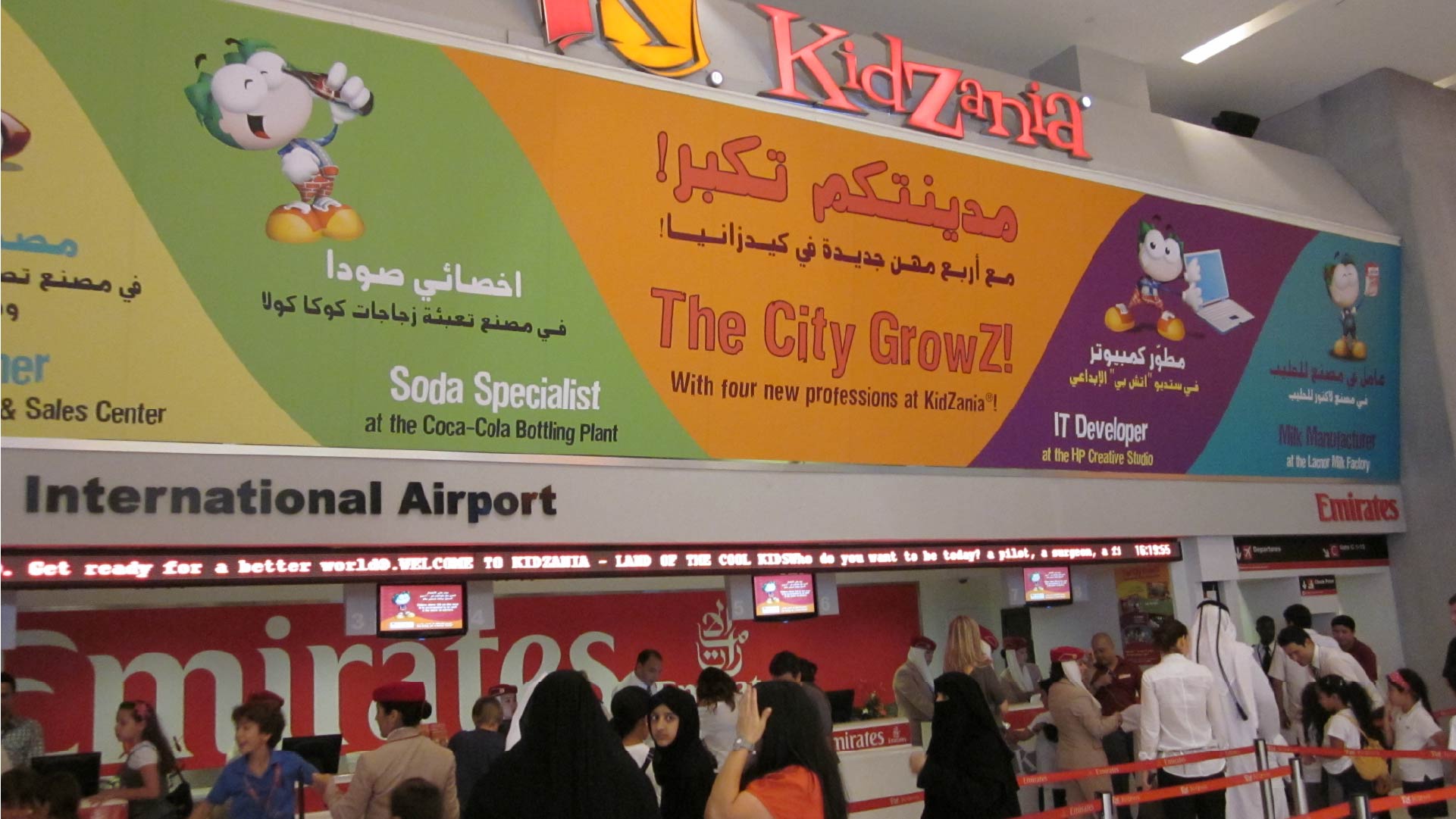The evolution of shopping malls and city centers
The retail market around the world experienced an enormous boom with the introduction and development of the shopping mall. In the 50’s of the 20th century, entertainment was first introduced in shopping malls in the US and Canada. It began quite simple with Christmas decorations and meet & greet with Santa Claus, most of the times combined with some small food & beverage facilities. Enough to create some atmosphere to keep people longer in the mall and to give them something extra.
Shopping and leisure fused together.
In Europe the situation was slightly different. City centers which became a shopping destination, also introduced some small food & beverages facilities, later following the US with Christmas decorations. There are less shopping malls in Europe, mostly due to the different layout of the cities. However, they are developing more and more in the last few decades and are becoming a serious alternative for retail in the city centers. A few advantages are the location next to a highway or a train station, good and cheap (mostly free) parking facilities and the large amount of facilities.
A major shift in terms of retail habits occurred when people began to shop for fun, as a way to spend their leisure time. Shopping became entertainment (funshopping, shoptainment or retailment) and the mall and city centers a place to meet and to relax. In several countries the mall became the ultimate leisure place.
The first amusement park in a shopping center was opened in 1981 in the West Edmonton Mall. Nowadays this indoor park is called “Galaxy Land” and forms with some other attractions, one of the largest indoor parks in the world, approximately 37,000 m2. Strangely this development was limited until 1992, when a second indoor park opened in the Mall of America. In Europe we saw the rise of amusement in or near city center, like Tivoli in Copenhagen. In the Middle East and Asia, large entertainment centers in malls where developed, in some cases containing a dazzling amount of attractions and facilities.
There are projects in development for many more of these kind malls, especially in the Middle East. Saudi Arabia has several mega projects planned or already in development. The country also aims to attract tourists from all over the world to the country. Two examples of these projects are the Line, a 170 kilometers urban development project with lots of leisure facilities. The other one is Trojena mountain tourism destination, which is planned to open in 2024. These new developments are (in most cases) characterized by a combination of leisure, living, work and retail.
Figure 1. West Edmonton Mall with the world’s largest indoor park

Entertainment makes areas more attractive to live, work, shop and relax
What makes urban areas lively and attractive to work, life, shop and relax? A combination of leisure facilities, design, nature and culture. Nothing new for many of us. City centers need to transform to life style centers, where leisure is as important as living, working and shopping. The presence of leisure is a major part of urban life and a major human need. Malls are also more and more transformed in these kind of centers, where shopping is combined with all kinds of other facilities and activities. In this way they become a 24-7 life style destination center, where people work, shop, relax, play and life.
Strangely enough, there is still not enough attention for leisure activities and facilities in city centers and malls, especially in Europe. The real importance of leisure is still not accepted by mall owners, city planners, urban developers, architects, city councils and other parties involved in urban development. And that’s strange, especially because the largest target groups, youth and young adults, are abundant at these locations.
Recent research in countries all over the world, states the importance of leisure facilities at these locations again and again. It reduces for example anti-social and criminal behavior. Leisure affects a person’s mental state in a positive way. The right kind of leisure planning can help to raise young people to responsible and social active citizens. For US citizens, leisure is the most important reason tot visit a mall! People are looking for entertainment, they want to enjoy themselves, meet friends and relax.
“A good mall is like a good partner, it offers entertainment, excitement & enlightenment” (author unknown)
Impact of entertainment
Nowadays the biggest leisure destination in the world is not one of the famous Disney’s parks, but a mall. Dubai Mall became the nr 1 leisure destination, with nearly 50 million visitors a year. The mall consists of a combination of leisure and retail facilities. Some examples of leisure facilities are Sega World, Kidzania, an indoor ice-skating and an aquarium. Other malls in Dubai have similar combinations of leisure and retail. Even bigger malls are being planned in Saoedie-Arabië, where the sky is the limit and investment in these facilities and attractions, are no problem at all.
Figure 2. Impression Dubai Mall aquarium

Figure 3. Kidzania theme park in Dubai Mall

What’s even more interesting, as mentioned earlier, we see malls and city centers transfer into life style centers. Urban design is becoming more attractive, more exiting and more and more facilities and activities are being combined. In Asia, especially in China and South-Korea, we see large developments in this field.
Figure 4. Life Style Center development model©

The urban environment around the world is changing constantly. The pace varies but the challenges are the same. Solutions are emerging and entertainment is one of the key factors to develop urban areas and unlock the potential. The introduction of entertainment, recreational areas and attractions, creates an opportunity for malls and city centers to develop more and more into attractive life style centers. Including them as a partner in a mix with other functies, will ensure a large spin-off.
Several international studies on the impact of entertainment on urban areas (mostly done in the US, Canada and Middle-East) give us some interesting insight. The main facts and figures are:
- Additional footfall in shopping malls, with the introduction of entertainment, is averaging around 5%;
- People are willing to travel longer for a visit and stay longer when more facilities and attractions are combined;
- Research shows an 10% additional income for other tenants in malls and urban centers;
- Only 16% of visitors to a mall or city center are just focusing on shopping. 84% has more reasons to visit, entertainment being the number 1 reason;
- The choice to visit a certain mall or city center, depends for over 40% on the availability of leisure facilities;
- Approximately between 7 and 10% of the visitors of a mall with an indoor entertainment park, are just visiting for the entertainment. 25% Of these visitors are also shopping and spent about 75% of what the normal visitor spent;
- Entertainment attracts especially families with children. Parks act as a trigger for families with young children. New forms of entertainment, like sportbars and VR centers, attract older age groups;
- The positive and safe atmosphere contributes to more repeat visits;
- Malls with entertainment facilities attract mostly somewhat higher income groups;
- One of the interesting spin-off effects is more visits to restaurants;
- The total sales of products will increase (reference is approximately € 250 per square meter extra).
In general all studies conclude a positive relationship between entertainment and profit (economical as well as the positive aspect on the overall well-being of people). The key question then is, why not invest in leisure facilities? Why are developers still so reluctant? Why is leisure still not as important as other developments, like living, work and retail, in urban development?
What kind of entertainment should be developed?
Different forms of entertainment could be developed in urban areas, depending on several factors, like the location, target groups, constraints, local culture, special wishes and investment. This list of attractions and facilities has not the intention to be complete, but shows some opportunities:
- Children play areas with different kind of equipment (indoor or outdoor)
- VR attractions
- Indoor ski
- Bowling
- Bars & restaurants
- Sport facilities
- Cinema
- Ice-rank
- Casino
- Wellness
- Skate facilities
- Biljart
- Darts
- Sportsbar
- Theatre
- Arcade halls
- Themed attraction park
- And more…
All these examples are already available in several malls and city centers all over the world, especially in the Middle-East, Asia and the US. In nearly all these locations we see a combination of these facilities and attractions, characterized by:
- A beautiful design;
- An overall experience that arouses all senses (immersive);
- Themed;
- High quality
- Overall pleasant, safe and lively atmosphere (in many cases combined with plants to create a sort of nature environment).
The next step
Most entertainment centers (EC’s) in malls rely on the building blocks of small rides, children’s play, arcades and games. They offer basic off-theshelf experiences. There is little or no theming and the integration with the neighbors, like bars, restaurants and stores, is mostly poor. Entertainment 1.0. This is in most cases still profitable, but visitor expectations move on. We have entered the time of experiences.
In city centers we see partly the same situation, depending on available spaces, small facilities still dominate the landscape. Mostly at the wrong location, due to lack of locations, high lease prices and regulations. It’s changing, new forms of leisure are developing in cities all over Europe (like for example Game State, the Gaming Factory, Frameless and O’Leary’s), but there is still a long way to go.
We see several trends in urban developments at the moment, but the integration of leisure with other urban activities doesn’t get the intention that it deserves and needs. Stakeholders still underestimate the importance of leisure. Next to this, it’s also quite difficult to finance leisure facilities. The risks are quite different then other investments and difficult to estimate. The return on investment depends on several uncertain factors, what makes it less attractive for investors. The potential solution for this is looking different and broader to urban developments and invest in package deals, with leisure as an important part. Integration is the key, also in investing. Combine real estate, leisure, living and retail.
Some personal thoughts
As a leisure consultant, I see the enormous potential leisure facilities and attractions can bring to urban areas. I look at it in a broader perspective then probably most stakeholders do. By doing so, the advantages are more clear, the return on investment is enormous and the risk of investing is relatively low.
My advice, take a good look at all the advantages leisure development can bring to your location. Invest some time in looking at some great examples worldwide. Study them, visit them, talk to the developers and the management and then decide to proceed. Create a good overall concept, focus on the right target groups and integrate leisure in your urban developments. It’s really worthwhile.





